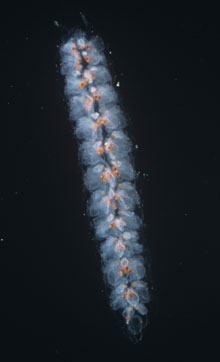A hitherto unknown way of burying carbon at the bottom of the sea
 In 2006 Mario Lebrato and Daniel Jones of the National Oceanography Centre in Southampton, England, were using a remotely operated deep-sea vehicle to study the sea floor near an oil pipeline off Côte d’Ivoire. What they found surprised them. It was a thaliacean graveyard. And its discovery throws into question the received wisdom about one important aspect of climate change, namely how much carbon from the atmosphere ends up at the bottom of the sea.
In 2006 Mario Lebrato and Daniel Jones of the National Oceanography Centre in Southampton, England, were using a remotely operated deep-sea vehicle to study the sea floor near an oil pipeline off Côte d’Ivoire. What they found surprised them. It was a thaliacean graveyard. And its discovery throws into question the received wisdom about one important aspect of climate change, namely how much carbon from the atmosphere ends up at the bottom of the sea.
Despite their unfamiliarity to most people, thaliaceans (a colony of which is pictured) are abundant creatures in many parts of the ocean. Their bodies are transparent and gelatinous, like those of jellyfish. They are not jellyfish, though. They are actually chordates—in other words, part of the same group of animals as humans, even though they do not have backbones. The thaliacean graveyard off Côte d’Ivoire came as a surprise because not much was known at the time about what happens to animals with gelatinous bodies, whether chordates or jellyfish, after they have died. And it set Mr Lebrato and Dr Jones thinking, because if thaliaceans are falling to the bottom of the sea in large numbers, they might be taking a lot of carbon with them.
Until then gelatinous animals had largely been ignored by researchers studying the carbon cycle (the way that element moves through land, sea, air and living creatures) because gelatinous bodies were thought to contain a lot of water and thus relatively little carbon. However, as Mr Lebrato and Dr Jones report in Limnology and Oceanography, when they analysed thaliacean tissues they found that the creatures were one-third carbon by weight. That was much more than they expected. Jellyfish, by comparison, are 10% carbon, and diatoms (single-celled algae that are common in plankton) 20%. It also helps explain why thaliaceans are so dense—and thus sink so quickly after they die.
Hitherto it was assumed that the main way carbon gets from the top to the bottom of the ocean was as part of dead planktonic algae sinking to the seabed. But the discovery of just how carbon-rich and prone to sinking thaliaceans are may change that assumption. Because they gather by the billion in feeding swarms around the world (they eat single-celled algae), the amount of carbon thaliaceans are taking to the bottom of the sea is by no means trivial, according to Mr Lebrato. He admits it is difficult to make accurate comparisons, because the research is still in its infancy. But he estimates that the “jelly pump”, as he refers to it, sinks almost twice as much carbon as algae do.
The question is, does that carbon stay down once it has arrived? That is unclear. The one sure way of keeping carbon on the seabed is in the form of calcium carbonate, the main ingredient of most animal shells. But thaliaceans have no shells. Nevertheless, some thaliaceans get buried before they have completely decomposed, and other researchers have found evidence that dead jellyfish sometimes accumulate in trenches without much decomposition, so perhaps thaliaceans do, too.
Even if the carbon is not permanently buried, the lack of mixing between deep and shallow water in the ocean means that it is likely to stay down there for a long time—something that will have to be added to computer models of how the climate works. The carbon cycle has thus acquired another epicycle, and become even more complicated to understand than it was.
Source: The Economist
Short link: http://whatel.se/~g9a2$2o

Recent Comments